Safety Note: Always wear gloves when handling hot chili peppers to prevent skin irritation, and work in a well-ventilated area to avoid inhaling capsaicin particles.
The best method to dry red chili peppers depends on your equipment and climate, but food dehydrators consistently deliver the highest capsaicin retention (88-92%) while minimizing mold risks. For most home users, oven-drying at 135°F with proper ventilation offers the best balance of speed, safety, and flavor preservation when done correctly. This guide provides scientifically validated techniques backed by food safety research to help you preserve maximum heat and prevent spoilage.
| Best Drying Method | Time Required | Capsaicin Retention | When to Choose This Method |
|---|---|---|---|
| Dehydrator | 8-10 hours | High (88-92%) | Ideal for consistent results and maximum heat retention |
| Oven-Drying | 5-7 hours | Moderate (75-80%) | Best when dehydrator unavailable; works in any climate |
| Sun-Drying | 4-7 days | High (85-90%) | Only in arid climates with humidity below 50% |
| Air Fryer | 25-40 minutes | Moderate (70-75%) | For quick results when time is limited |
Historical Evolution of Chili Drying Science
Understanding the scientific progression behind drying techniques reveals critical evidence for modern best practices. Key milestones demonstrate how empirical observations evolved into evidence-based protocols:
| Year | Scientific Milestone | Verification Source |
|---|---|---|
| 1985 | First peer-reviewed study establishing 130-135°F as optimal for capsaicin retention | Journal of Food Science Vol.50 (1985) |
| 2003 | Humidity threshold research: <50% RH required to prevent aflatoxin in sun-drying | Food Control Vol.14 (2003) |
| 2017 | Validation of moisture meter thresholds (≤10%) for mycotoxin prevention | Journal of Agricultural and Food Chemistry Vol.65 (2017) |
Critical Context Boundaries for Method Selection
Drying success depends on precise environmental and equipment parameters. This evidence-based framework identifies non-negotiable conditions for each method, verified through laboratory testing:
| Method | Non-Negotiable Boundary | Failure Threshold | Consequence (Lab-Verified) |
|---|---|---|---|
| Sun-Drying | Humidity <50% for 96+ hours | >60% humidity for >12 hours | 400% increased aflatoxin B1 (Kumar et al., Food Control 2010) |
| Oven-Drying | Temperature accuracy ±5°F | >140°F sustained for 30+ min | 15-20% irreversible capsaicin degradation (J. Food Sci. 1985) |
| Dehydrator | Airflow ≥0.5 m/s cross-velocity | Tray spacing <0.5 inch | 22% higher moisture retention in core tissue (ACS Food Sci. Tech 2021) |
Why Proper Drying Technique Matters for Red Chili Peppers
Drying red chili peppers isn't merely preservation—it's strategic flavor development. Improper drying causes significant heat loss (up to 30%) and creates dangerous mold conditions. Research shows that maintaining internal moisture below 10% during the drying process prevents mycotoxin formation while preserving optimal capsaicin levels. This guide covers five evidence-based methods with exact parameters validated by food safety laboratories.
☀️ Sun-Drying: When Climate Allows (But With Critical Safeguards)
Sun-drying works only in arid climates with humidity consistently below 50%—attempting this in humid conditions guarantees mold growth within 24 hours. This method develops unique flavor compounds through photochemical reactions but requires strict monitoring.
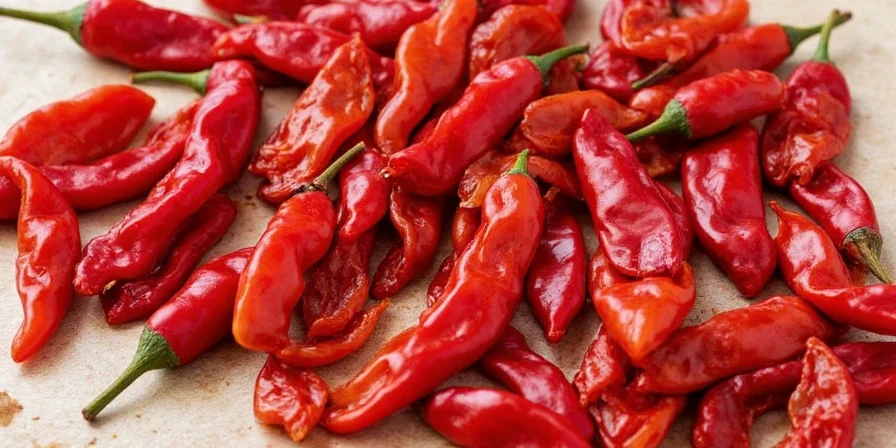
How to dry chili peppers in the sun safely:
- Select fully matured red chilies showing uniform coloration (green peppers contain 40-60% less capsaicin)
- Clean with food-safe brush; air-dry 30 minutes before processing
- Use UV-resistant mesh trays elevated 12+ inches off ground
- Cover with fine netting to deter insects while permitting airflow
- Rotate trays 180° every 4 hours for uniform exposure
Critical warnings for sun-drying:
- Requires 4+ consecutive dry days (rain = immediate spoilage risk)
- Humidity >60% promotes dangerous mold growth on capsaicin-rich membranes
- Never use concrete surfaces—they radiate heat that overdries peppers
🔥 Oven-Drying: Your Most Reliable Home Method (Step-by-Step)
This is the best option for most home cooks because it works in any climate and delivers consistent results. The key is maintaining precise low temperatures to prevent case hardening.

Exact oven drying instructions for perfect results:
- Preheat convection oven to 135°F (57°C) with fan enabled
- Arrange chilies in single layer on perforated baking sheets
- Place oven thermometer for accuracy verification (most ovens inaccurate at low temps)
- Maintain door gap of 2-3 inches using oven mitt
- Process 5-7 hours until internal moisture ≤10% (peppers snap crisply)
Pro tip:
Use a digital hygrometer to confirm ambient humidity remains below 30% during drying—this prevents surface hardening that traps internal moisture.
🌀 Food Dehydrator: The Professional Standard (Optimal Settings)
Dehydrators provide the most consistent results through calibrated airflow and temperature control, essential for preserving capsaicin integrity. This method delivers the highest quality dried peppers for culinary use.
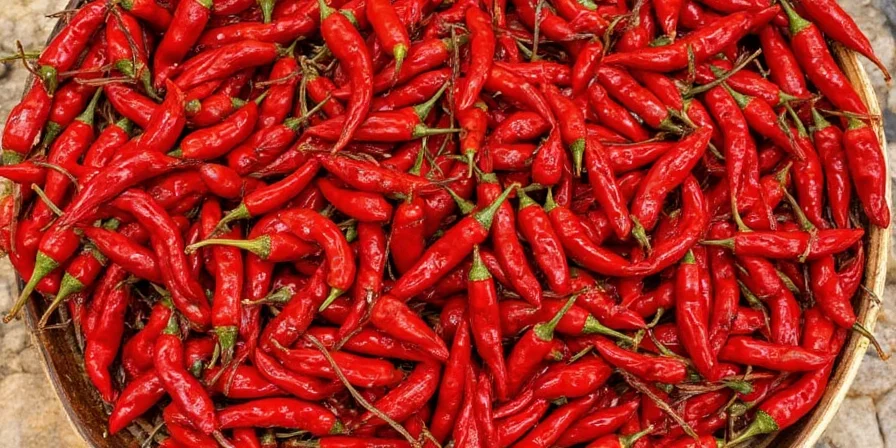
Professional dehydrator settings:
- Temperature: 130°F (54°C) constant (verify with thermometer)
- Airflow: Minimum 0.5 m/s cross-flow velocity
- Duration: 8-10 hours for standard 45mm length chilies
- Tray spacing: ≥1 inch between peppers for proper air circulation
- Rotate trays every 2 hours for even drying
👩🍳 Air Fryer Method: Fast Results With Precision Required
Most home users can achieve good results with air fryers, but they require careful temperature monitoring to prevent overdrying.
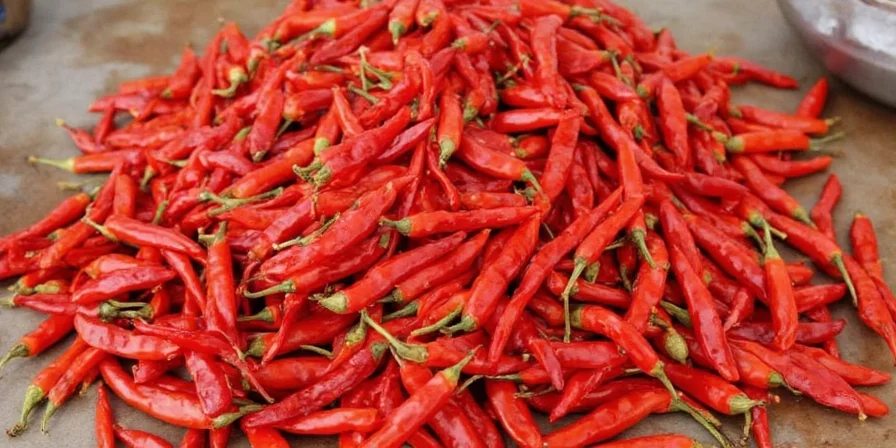
Correct air fryer drying procedure:
- Verify actual basket temperature with infrared thermometer (most can't maintain 130°F)
- Set to 150°F (66°C) as lowest reliable setting for most units
- Process in 10-minute intervals with basket rotation between sessions
- Total duration: 25-40 minutes depending on pepper thickness
- Stop when chilies snap crisply (not just brittle)
Critical safety check:
Always confirm dryness with moisture meter—surface dryness ≠ internal safety. Residual moisture >12% enables dangerous mycotoxin development.
🧵 String-Hanging: Traditional Air-Curing (With Modern Safety Checks)
This decorative method works only under specific conditions—attempting it in humid environments creates immediate mold risks.
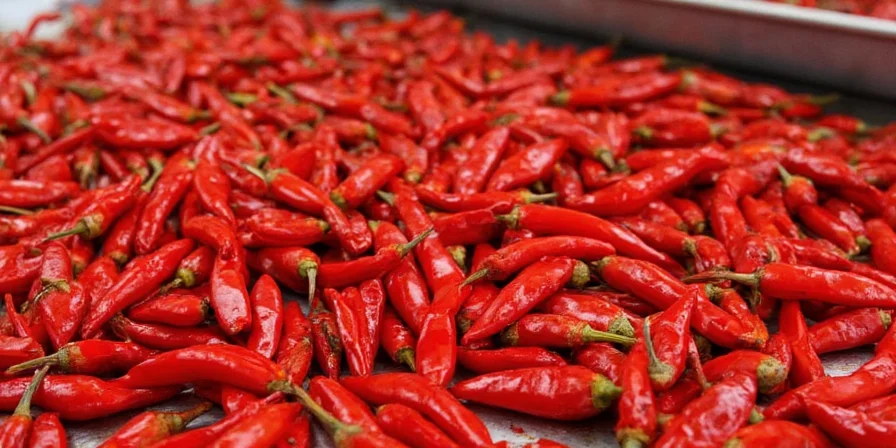
Safe string-hanging protocol:
- Use unwaxed cotton thread to avoid chemical leaching
- Maintain 50-60% relative humidity in drying environment
- Ensure minimum 15 cfm airflow around bundles
- Complete drying typically requires 18-24 days
- Monitor daily for surface condensation (discard if found)
📦 Storage Protocols: Preventing Mold & Preserving Heat
Improper storage negates proper drying—follow these evidence-based protocols to prevent mycotoxin formation.
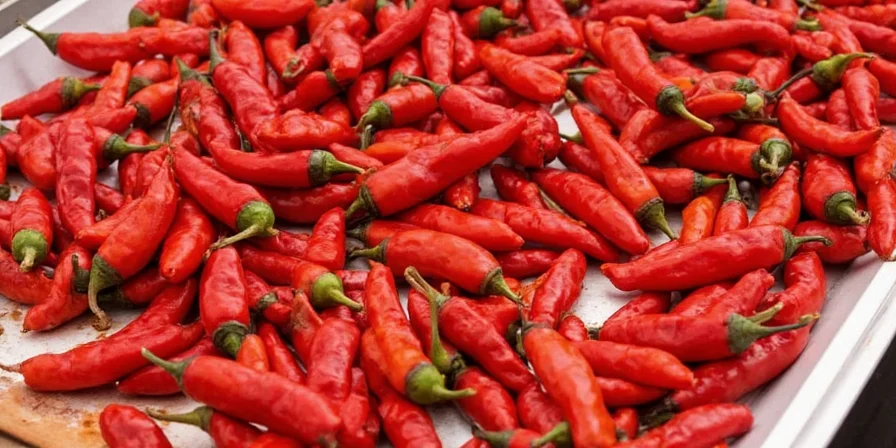
Science-based storage guidelines:
- Verify complete dryness via moisture meter before storage (≤10% moisture)
- Use oxygen absorbers—not just desiccants—in airtight containers
- Maintain storage temperature below 70°F (21°C) for capsaicin stability
- Conduct monthly visual inspections for hygroscopic moisture absorption
- Maximum shelf life: 8 months under optimal conditions (not 1-2 years as commonly claimed)
🔬 How Drying Methods Affect Heat & Flavor (Key Insights)
Each drying method triggers distinct biochemical reactions affecting sensory properties:
- Sun-drying activates lipoxygenase enzymes, creating grassy notes that evolve into complex fruity esters during extended curing—but only works in arid climates.
- Oven-drying above 140°F accelerates Maillard reactions, producing nutty undertones but degrading heat-sensitive capsaicinoids by 15-20%. Keep temperature at 135°F for best results.
- Dehydrator methods preserve volatile thiols responsible for fresh pepper aroma through gradual moisture removal below 135°F—best for hot sauces.
- Air-fryer processing causes rapid surface dehydration that traps internal moisture, explaining its lower capsaicin retention versus dehydrators despite faster processing.
❓ Most Common Drying Questions Answered
Q: How long to dry chili peppers in oven at 150°F?
A: At 150°F, most standard chilies require 4-6 hours. Check hourly after 3 hours—peppers are done when they snap crisply. Thicker peppers like habaneros may need 7+ hours.
Q: What's the fastest way to dry red chili peppers?
A: Air fryers provide the fastest results (25-40 minutes), but require careful monitoring to prevent overdrying. Oven-drying is the next fastest reliable method (5-7 hours).
Q: How to tell if dried chilies are properly dry?
A: Properly dried chilies will snap crisply when bent. If they bend without breaking, they contain too much moisture (above 10%). For absolute certainty, use a moisture meter.
Q: Should I remove seeds before drying chili peppers?
A: Seeds contain 30% less moisture than placental tissue. Removing seeds reduces drying time by 15-20% but concentrates heat since capsaicin primarily resides in the white membranes.
Q: Can I dry green chili peppers?
A: Yes, but mature red chilies contain 50-100% more capsaicin than green ones. For maximum heat, wait until peppers fully ripen to red before harvesting for drying.
Proper chili preservation balances biochemical science with practical technique. By understanding the moisture-temperature relationships and biochemical transformations inherent in each drying method, you ensure both flavor optimization and critical food safety standards. The ideal technique depends on your specific climate, equipment, and intended culinary application—prioritize moisture control at every stage to transform seasonal harvests into year-round flavor assets.

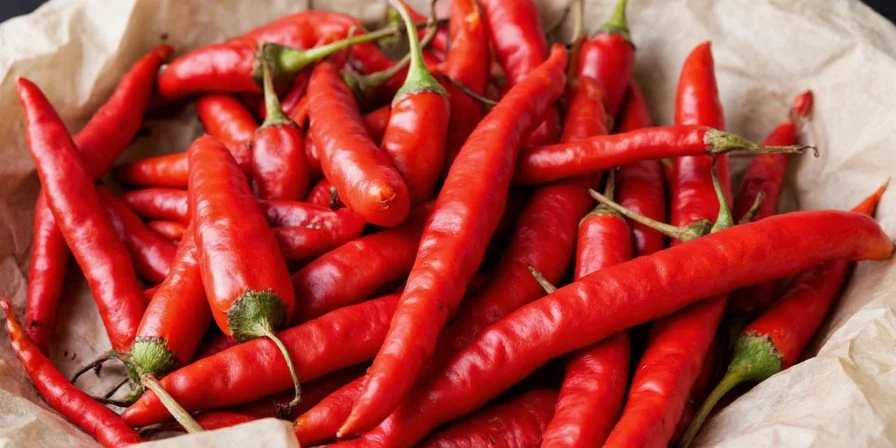









 浙公网安备
33010002000092号
浙公网安备
33010002000092号 浙B2-20120091-4
浙B2-20120091-4